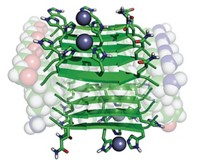Advertisement
Grab your lab coat. Let's get started
Welcome!
Welcome!
Create an account below to get 6 C&EN articles per month, receive newsletters and more - all free.
It seems this is your first time logging in online. Please enter the following information to continue.
As an ACS member you automatically get access to this site. All we need is few more details to create your reading experience.
Not you? Sign in with a different account.
Not you? Sign in with a different account.
ERROR 1
ERROR 1
ERROR 2
ERROR 2
ERROR 2
ERROR 2
ERROR 2
Password and Confirm password must match.
If you have an ACS member number, please enter it here so we can link this account to your membership. (optional)
ERROR 2
ACS values your privacy. By submitting your information, you are gaining access to C&EN and subscribing to our weekly newsletter. We use the information you provide to make your reading experience better, and we will never sell your data to third party members.
Biological Chemistry
Picking Prion Infectivity Apart
New research suggests that infectious protein misfolding and Prion diseases’ neurological toxicity are independent processes
by Sarah Everts
February 28, 2011
| A version of this story appeared in
Volume 89, Issue 9
Prion disorders such as Creutzfeldt–Jakob disease and bovine spongiform encephalopathy have long kept researchers guessing about exactly how the diseases’ characteristically misfolded proteins lead to infectivity and toxicity. Research from John Collinge and colleagues at UCL Institute of Neurology, in London, suggests that the infectious refolding of normal proteins into misfolded versions and prion diseases’ neurological toxicity are independent processes (Nature, DOI: 10.1038/nature09768). The researchers note that “prions themselves are not neurotoxic but catalyze the formation of such species.” Working with mouse models, Collinge’s team showed that infectious prion proteins catalyze the increase in concentration of misfolded proteins, but that during this phase no clinically relevant toxicity occurs. Only after the misfolded prion proteins reach a saturation concentration does neurotoxicity initiate. In a commentary about the work, Reed B. Wickner of the U.S.’s National Institute of Diabetes & Digestive & Kidney Diseases notes that this “simple experiment [shows] that the infectious and toxic particles are not the same.” Wickner adds that “this is unexpected and raises issues central to our understanding of prion diseases.”




Join the conversation
Contact the reporter
Submit a Letter to the Editor for publication
Engage with us on Twitter